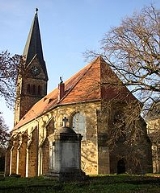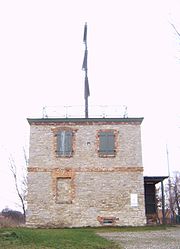
Am Großen Bruch
Encyclopedia
Am Großen Bruch is a municipality in the Börde
district
in Saxony-Anhalt
, Germany
. It is part of the Verbandsgemeinde
("collective municipality") Westliche Börde
.



meaning "Great Wetland" denotes the swampy area of a former glacial valley, stretching about 45 km (28 mi) from Oschersleben
and the Bode River
in the east to Hornburg
in the west. For centuries the inaccessible bog formed the border between the Duchy of Brunswick-Lüneburg
and the Bishopric of Halberstadt
.
Canons Regular
monastery which Reinhard, Bishop of Halberstadt had established at Osterwieck
three years earlier. The double monastery
also became the seat of an archdeacon
in 1178. It joined the Congregation of Windesheim
in 1452. During the Protestant Reformation
Hamersleben was devastated in the course of the German Peasants' War
in 1525, again by the troops of the then Lutheran Archbishopric of Magdeburg
and once again by the forces of the Swedish Empire
during the Thirty Years' War
. Nevertheless the abbey retained Roman Catholic
confession until its dissolution
in 1804. The Catholic monastery church of Saint Pancras is a Romanesque
building which is known for its Baroque
pipe organ built in 1688. Today it is a stop on the scenic Romanic Road
.
The village of Neuwegersleben features one of the few preserved stations of the Prussian
optical telegraph line from Berlin
to Koblenz
built in 1833. The building has been partly reconstructed and its signals were reinstalled. Today it houses a small museum.
No. 245 running from Halberstadt
to Haldensleben
. In Neuwegersleben the highway No. 246 to Wanzleben
branches off. The railway line from Oschersleben to Jerxheim
in Lower Saxony
was closed in 1992.
Börde
Börde, a district in Saxony-Anhalt in Germany, is arguably best known as the area of the former repository for radioactive waste Morsleben. The disposal of waste into the facility ended in 1998.- History :...
district
Districts of Germany
The districts of Germany are known as , except in the states of North Rhine-Westphalia and Schleswig-Holstein where they are known simply as ....
in Saxony-Anhalt
Saxony-Anhalt
Saxony-Anhalt is a landlocked state of Germany. Its capital is Magdeburg and it is surrounded by the German states of Lower Saxony, Brandenburg, Saxony, and Thuringia.Saxony-Anhalt covers an area of...
, Germany
Germany
Germany , officially the Federal Republic of Germany , is a federal parliamentary republic in Europe. The country consists of 16 states while the capital and largest city is Berlin. Germany covers an area of 357,021 km2 and has a largely temperate seasonal climate...
. It is part of the Verbandsgemeinde
Verbandsgemeinde
A Verbandsgemeinde is an administrative unit in the German Bundesländer of Rhineland-Palatinate and Saxony-Anhalt.-Rhineland-Palatinate:...
("collective municipality") Westliche Börde
Westliche Börde
Westliche Börde is a Verbandsgemeinde in the Börde district in Saxony-Anhalt, Germany. Before 1 January 2010, it was a Verwaltungsgemeinschaft. It is situated approx. 35 km southwest of Magdeburg, in the western part of the Magdeburger Börde...
.



Geography
The municipality arose on July 1, 2004 by the merger of the villages Gunsleben, Hamersleben, Neudamm and Neuwegersleben. The name Großes BruchGroßes Bruch
The Großes Bruch is a wetland area, 45 kilometres long, in Germany, situated between Oschersleben in Saxony-Anhalt in the east and Hornburg in the west. It was formed from a glacial valley...
meaning "Great Wetland" denotes the swampy area of a former glacial valley, stretching about 45 km (28 mi) from Oschersleben
Oschersleben
Oschersleben is a town in the Börde district, in Saxony-Anhalt, Germany. The population in 1905 was 13,271, in 2005 about 18,000.-Geography:...
and the Bode River
Bode River
The Bode is a river in the German state of Saxony-Anhalt, a left tributary of the Saale.It rises in the Harz mountains and drains them in a northerly direction. After it discharges into the Saale at Nienburg...
in the east to Hornburg
Hornburg
Hornburg is a town in the Wolfenbüttel district, in the German state of Lower Saxony. It is situated at the Ilse river, a tributary of the Oker. Hornburg is part of the Samtgemeinde Schladen and home to numerous historically valuable half-timber buildings...
in the west. For centuries the inaccessible bog formed the border between the Duchy of Brunswick-Lüneburg
Brunswick-Lüneburg
The Duchy of Brunswick-Lüneburg , or more properly Duchy of Brunswick and Lüneburg, was an historical ducal state from the late Middle Ages until the late Early Modern era within the North-Western domains of the Holy Roman Empire of the German Nation, in what is now northern Germany...
and the Bishopric of Halberstadt
Bishopric of Halberstadt
The Bishopric of Halberstadt was a Roman Catholic diocese from 804 until 1648 and an ecclesiastical state of the Holy Roman Empire from the late Middle Ages...
.
History
Hamersleben was first mentioned in a 1021 deed and in 1111 became the home of an AugustinianAugustinians
The term Augustinians, named after Saint Augustine of Hippo , applies to two separate and unrelated types of Catholic religious orders:...
Canons Regular
Canons Regular
Canons Regular are members of certain bodies of Canons living in community under the Augustinian Rule , and sharing their property in common...
monastery which Reinhard, Bishop of Halberstadt had established at Osterwieck
Osterwieck
Osterwieck is a historic town in the Harz district, in the German state of Saxony-Anhalt. It is situated on the river Ilse, north of Wernigerode and the Harz mountain range. On 1 January 2010 the municipalities of the former Verwaltungsgemeinschaft Osterwieck-Fallstein merged in Osterwieck.The...
three years earlier. The double monastery
Double monastery
A double monastery is an institution combining a separate monastery for monks and an abbey for nuns. Examples include Coldingham Monastery in Scotland, and Einsiedeln Abbey and Fahr Abbey in Switzerland, controlled by the abbot of Einsiedeln...
also became the seat of an archdeacon
Archdeacon
An archdeacon is a senior clergy position in Anglicanism, Syrian Malabar Nasrani, Chaldean Catholic, and some other Christian denominations, above that of most clergy and below a bishop. In the High Middle Ages it was the most senior diocesan position below a bishop in the Roman Catholic Church...
in 1178. It joined the Congregation of Windesheim
Congregation of Windesheim
The Congregation of Windesheim was a branch of the Augustinians. It took its name from an Augustinian monastery about four miles south of Zwolle on the IJssel, in the Netherlands....
in 1452. During the Protestant Reformation
Protestant Reformation
The Protestant Reformation was a 16th-century split within Western Christianity initiated by Martin Luther, John Calvin and other early Protestants. The efforts of the self-described "reformers", who objected to the doctrines, rituals and ecclesiastical structure of the Roman Catholic Church, led...
Hamersleben was devastated in the course of the German Peasants' War
German Peasants' War
The German Peasants' War or Great Peasants' Revolt was a widespread popular revolt in the German-speaking areas of Central Europe, 1524–1526. At its height in the spring and summer of 1525, the conflict involved an estimated 300,000 peasants: contemporary estimates put the dead at 100,000...
in 1525, again by the troops of the then Lutheran Archbishopric of Magdeburg
Archbishopric of Magdeburg
The Archbishopric of Magdeburg was a Roman Catholic archdiocese and Prince-Bishopric of the Holy Roman Empire centered on the city of Magdeburg on the Elbe River....
and once again by the forces of the Swedish Empire
Swedish Empire
The Swedish Empire refers to the Kingdom of Sweden between 1561 and 1721 . During this time, Sweden was one of the great European powers. In Swedish, the period is called Stormaktstiden, literally meaning "the Great Power Era"...
during the Thirty Years' War
Thirty Years' War
The Thirty Years' War was fought primarily in what is now Germany, and at various points involved most countries in Europe. It was one of the most destructive conflicts in European history....
. Nevertheless the abbey retained Roman Catholic
Roman Catholic Church
The Catholic Church, also known as the Roman Catholic Church, is the world's largest Christian church, with over a billion members. Led by the Pope, it defines its mission as spreading the gospel of Jesus Christ, administering the sacraments and exercising charity...
confession until its dissolution
German Mediatisation
The German Mediatisation was the series of mediatisations and secularisations that occurred in Germany between 1795 and 1814, during the latter part of the era of the French Revolution and then the Napoleonic Era....
in 1804. The Catholic monastery church of Saint Pancras is a Romanesque
Romanesque architecture
Romanesque architecture is an architectural style of Medieval Europe characterised by semi-circular arches. There is no consensus for the beginning date of the Romanesque architecture, with proposals ranging from the 6th to the 10th century. It developed in the 12th century into the Gothic style,...
building which is known for its Baroque
Baroque
The Baroque is a period and the style that used exaggerated motion and clear, easily interpreted detail to produce drama, tension, exuberance, and grandeur in sculpture, painting, literature, dance, and music...
pipe organ built in 1688. Today it is a stop on the scenic Romanic Road
Romanic Road
The Romanesque Road is a scenic holiday route in the German state of Saxony-Anhalt. The route takes the form of a figure-of-eight, with a northern and a southern loop, and the city of Magdeburg as it centre, linking village churches, monasteries, cathedrals and castles built between 950 and 1250...
.
The village of Neuwegersleben features one of the few preserved stations of the Prussian
Kingdom of Prussia
The Kingdom of Prussia was a German kingdom from 1701 to 1918. Until the defeat of Germany in World War I, it comprised almost two-thirds of the area of the German Empire...
optical telegraph line from Berlin
Berlin
Berlin is the capital city of Germany and is one of the 16 states of Germany. With a population of 3.45 million people, Berlin is Germany's largest city. It is the second most populous city proper and the seventh most populous urban area in the European Union...
to Koblenz
Koblenz
Koblenz is a German city situated on both banks of the Rhine at its confluence with the Moselle, where the Deutsches Eck and its monument are situated.As Koblenz was one of the military posts established by Drusus about 8 BC, the...
built in 1833. The building has been partly reconstructed and its signals were reinstalled. Today it houses a small museum.
Transportation
Am Großen Bruch is located on the federal highwayBundesstraße
Bundesstraße , abbreviated B, is the denotation for German and Austrian national highways.-Germany:...
No. 245 running from Halberstadt
Halberstadt
Halberstadt is a town in the German state of Saxony-Anhalt and the capital of the district of Harz. It is located on the German Half-Timbered House Road and the Magdeburg–Thale railway....
to Haldensleben
Haldensleben
Haldensleben is a town in Saxony-Anhalt, Germany. It is situated on the Ohre river, approx. 30 km northwest from Magdeburg. It is connected by railway to Magdeburg, Oebisfelde and Eilsleben. It is the capital of the district Börde. It has a Protestant and a Catholic church. An old equestrian...
. In Neuwegersleben the highway No. 246 to Wanzleben
Wanzleben
Wanzleben is a town and a former municipality in the Börde district, in Saxony-Anhalt, Germany. Since 1 January 2010, it is part of the town Wanzleben-Börde. It is situated approx. 15 km southwest of Magdeburg....
branches off. The railway line from Oschersleben to Jerxheim
Jerxheim
Jerxheim is a municipality in the district of Helmstedt, in Lower Saxony, Germany....
in Lower Saxony
Lower Saxony
Lower Saxony is a German state situated in north-western Germany and is second in area and fourth in population among the sixteen states of Germany...
was closed in 1992.

